Crazy forks in equilibrium
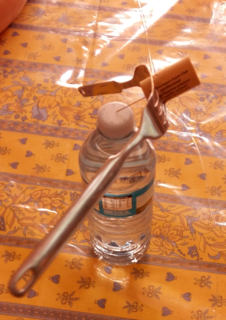
[image credits: Myself]
I put a little time to write this article: although the experiment described below is relatively simple, I did not know where to begin with for explaining the phenomenon. However, after my last post related to masses, weights and gravity, things are now much simpler today.
One of the important things that children need to learn is to walk and keep their balance. Trying to understand how balance (and their center of gravity) works consists hence of a good opportunity for many funny activities for kids.
The experiment that I will describe below is very simple, but it is actually quite challenging to understand!
Starting question
How to allow a certain object of a certain weight to be in equilibrium? In other words, one puts it on a flat surface, and it has to stay still.
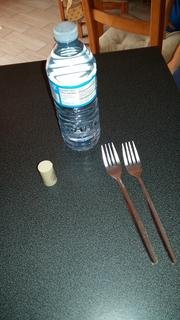
[image credits: Myself]
Phenomenon to observe
Notion of gravity and balance
Material required for the experiment
- A cork
- A needle (or a toothpick)
- Two identical forks (they must have exactly the same weight)
- A bottle
Step 1
Pin the needle or the toothpick in the middle of one of the ends of the cork.
Questions asked to Zachary, 6 years old
What will happen if you put the needle on a flat surface, with the cork on top of it?
The answer was: Well, the cork will stay on the needle without falling!
He is then asked to put the cork on the needle and try to keep it in equilibrium. He found that this was actually not possible.
Step 2
Pin the two forks on each side of the cork, in the middle or a little downwards, as symmetrically as possible.
Questions asked to Zachary
What do you think it will happen when we put our device on the top of the bottle?
The answer was immediate: It’s going to fall, it's too heavy!

[image credits: Myself]
Step 3
Put this strange object on the top of the bottle (closed of course) and observe what happens ...
Normally, the object should remain in perfect equilibrium even if it is jostled slightly. However, depending on how one manages to set the forks, this does not necessarily work on the first trial.
In our case, we first got a kind of funny satellite that orbited in a strange way above the bottle. After several manipulations, we nevertheless finally managed to get a system in rather stable equilibrium
Questions about the experiment that we asked to Zachary
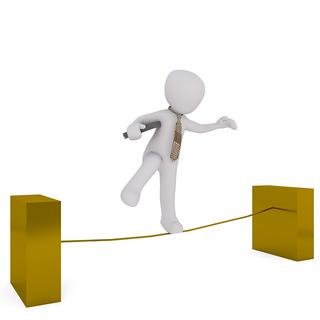
[image credits: Pixabay]
Why did the forks not fall?
Zachary explained us the manipulations that he made. With the needle alone, the assembly did not hold whereas with the forks it held. He was however unable to find an explanation for the phenomenon...
Do you know gravity? What can you tell me more about gravity?
At the time we did the experiment (i.e. some time ago), he knew the word ‘gravity’ but he was unable to explain what it was. I asked him the question again at the time of writing this post (i.e. yesterday), and the answer was more satisfactory.
This timeline also corresponds to a couple of weeks after we did the experiment with the tennis balls. From that, he knew that for example, when one takes a ball and drop it, it falls to the ground and do not float into the air.
Scientific explanations
The center of gravity
Every object around us has what is called a "center of gravity". The dictionary [2] gives us the following definition:
Point of concentration of the different forces that allows a body to be in equilibrium.
Another way of summarizing would be to say that it is a bit like having "the whole weight of the object entered on that point". [3]
Basically, one says that the center of gravity is "roughly" the center of the mass of the object, the place where its weight acts downward through the gravitational pull.
An object (or a person) will be in stable equilibrium if the projection of its center of gravity (in scientific language, one speaks of orthogonal projection) is found to lie inside what is called the support polygon.
The support polygon

[image credits: Pixabay]
In a few words, this simply consists of the floor space on which the object rests. The simplest way to see that is to imagine a person who stands, feet slightly apart from each other. One can imagine the surface formed when connecting his/her two feet, that resemble a kind of rectangle. This is the support polygon of that person. In this way, a person standing with their feet together will have a much smaller support polygon than with the feet apart.
When the center of gravity of the object or person points towards the support polygon, the equilibrium is stable. On the other hand, if the person's center of gravity deviates from the support polygon, the equilibrium is lost. The person will experience the force of gravity... and fall.
We can also show that lower is the center of gravity of a system, more stable is the system.
Back to our experience
The cork (alone) has a center of gravity and a support polygon that are aligned: it is thus stable on a flat surface.
The needle has a center of gravity approximately at its center. Placed vertically, the center of gravity is found quite high and with an extremely thin support polygon. It is therefore almost impossible to maintain it in equilibrium in this position.
Without any doubt, this should nevertheless be possible with very precise instruments. However, with our eyes as our sole tool, I challenge anyone to succeed here!
And the role of the forks in this story?
The extension of the system originating from the forks modifies its center of gravity which is then lying at a lower position. As said before, the lower the center of gravity, the more stable is the system. The support polygon is found in some way “inverted”. It is much larger so that the set is extremely stable and will even accept to be a little bit jostled!
The example of tightrope walkers
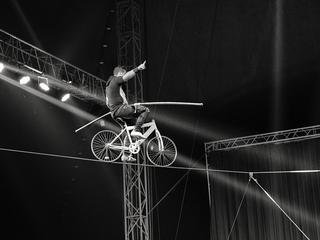
[image credits: Pixabay]
What we described above is actually what happens with tightrope walkers walking on a rope holding a pole. The tip of the poles modifies the location of their center of gravity: either by increasing their support polygon, or by positioning their center of gravity under their point of support, i.e. the wire on which they must walk…
Conclusion
Although the explanations are a bit difficult to get for children, the simple little experiments allow them to understand the basic principles behind support polygons. They can also start to play along these lines to test their own limits.
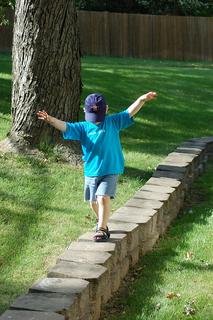
[image credits: Pixabay]
Here are some further ideas and do not hesitate to propose your own ideas!
- Ask the kids to first stand on one foot (like the cork on the needle), then on their two joined feet, then on both feet slightly apart, using their legs as if they were our forks;
Attempt various assemblies with forks modifying the location of the center of gravity of the cork/fork device;
Test the importance of the symmetries in a montage with, for example, a Kappla tower; - And of course, obstacle racing consists in a funny way to experiment gravity and equilibrium!
[2] http://www.linternaute.com/dictionnaire/fr/definition/centre-de-gravite
[3] http://lewebpedagogique.com/choukette/files/2011/06/La-m%C3%A9canique.pdf
[4] https://www.cairn.info/revue-staps-2005-1-page-59.htm
[5] www.lyc-dumont-maurepas.ac-versailles.fr/IMG/ppt/equilibres_final.ppt
[6] http://www.hugolescargot.com/apprendre/36006-les-fourchettes-equilibristes/
great work friend , good luck
Congratulations @lamouthe! You have completed some achievement on Steemit and have been rewarded with new badge(s) :
Click on any badge to view your own Board of Honor on SteemitBoard.
For more information about SteemitBoard, click here
If you no longer want to receive notifications, reply to this comment with the word
STOPCongratulations @lamouthe, this post is the seventh most rewarded post (based on pending payouts) in the last 12 hours written by a User account holder (accounts that hold between 0.1 and 1.0 Mega Vests). The total number of posts by User account holders during this period was 3177 and the total pending payments to posts in this category was $3651.04. To see the full list of highest paid posts across all accounts categories, click here.
If you do not wish to receive these messages in future, please reply stop to this comment.